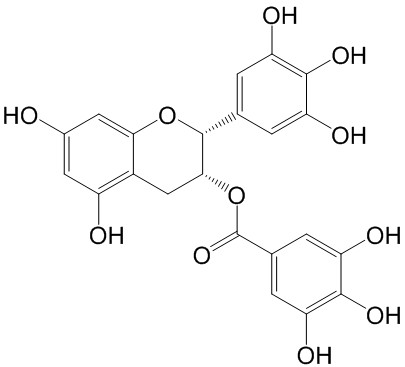Home
Products
(-)-Epigallocatechin gallate



| Product Name | (-)-Epigallocatechin gallate |
| Price: | $15 / 20mg |
| Catalog No.: | CN05522 |
| CAS No.: | 989-51-5 |
| Molecular Formula: | C22H18O11 |
| Molecular Weight: | 458.38 g/mol |
| Purity: | >=98% |
| Type of Compound: | Flavonoids |
| Physical Desc.: | White powder |
| Source: | The woods of Acacia catechu (L.F.) Willd. |
| Solvent: | Chloroform, Dichloromethane, Ethyl Acetate, DMSO, Acetone, etc. |
| SMILES: | Oc1cc(O)c2c(c1)O[C@@H]([C@@H](C2)OC(=O)c1cc(O)c(c(c1)O)O)c1cc(O)c(c(c1)O)O |
| Contact us | |
|---|---|
| First Name: | |
| Last Name: | |
| E-mail: | |
| Question: | |
| Description | (-)-Epigallocatechin Gallate is an antioxidant polyphenol flavonoid form green tea, and inhibits the activation of EGFR, HER2 and HER3, with antitumor activity. |
| Target | EGFR HER2 HER3 |
| In Vitro | (-)-Epigallocatechin Gallate (EGCG) inhibits activation EGFR, HER2 and HER3 in the SW837 human colon cancer cell line. (-)-Epigallocatechin Gallate (10 μM) also inhibits cell growth, suppresses activation of EGFR, HER2, and HER3, and causes decrease in the levels of COX-2 and Bcl-xL proteins, and apoptosis after treatment for 96 h[1]. (-)-Epigallocatechin Gallate (0-35 μg/mL) inhibits the proliferation of colorectal cancer cells. (-)-Epigallocatechin Gallate (35 μg/mL) induces apoptosis of colorectal cancer cells[2]. (-)-Epigallocatechin Gallate (EGCG; 50, 75 and 100 μM) dose-dependently inhibits the growth of HepG2 cells, and induces apoptosis in HepG2 cells[3]. |
| In Vivo | (-)-Epigallocatechin Gallate (5, 10, and 20 mg/kg, p.o.) inhibits the growth of orthotopic colorectal cancer cells in mice[2]. |
| Cell Assay | LoVo, SW480, HCT-8, and HT-29 cells are seeded in 96-well plates at a concentration of 5×103 cells; each cell line is totally seeded in the 12 wells. Complete medium is added to the wells, up to 200 μL; the medium contains 0 μg/mL, 10 μg/mL, 20 μg/mL, and 35 μg/mL of (-)-Epigallocatechin Gallate. The inhibition rate=[1 - (absorbance of (-)-Epigallocatechin Gallate group - absorbance of control group)/(absorbance of control group - absorbance of blank control group)] × 100[2]. |
| Animal Admin | Mice[2] At 2 weeks postsurgery, 39 out of the 40 nude mice presented with tumors. Based on the volume of the tumors, the 39 mice with tumors are divided into four groups: a control group (n=9); a group that receives 5 mg/kg of (-)-Epigallocatechin Gallate (n=10); a group that receives 10 mg/kg of (-)-Epigallocatechin Gallate (n=10); and a group that receives 20 mg/kg of (-)-Epigallocatechin Gallate (n=10). In the therapeutic groups, (-)-Epigallocatechin Gallate is administrated intragastrically, and in the control group, 100 uL of physiological saline is administrated intragastrically, once daily for 14 days. After the treatment of the mice with (-)-Epigallocatechin Gallate for 4 weeks, the growth and metastasis of the primary tumors are continuously monitored using a fluorescent imaging system. After 4 weeks, the primary tumors are weighed and immediately put into liquid nitrogen (−196°C) and 2 to 3 hours later, these specimens are stored at −80°C. In addition, the other parts of the primary tumor and metastases are fixed in 4% formaldehyde[2]. |
| Density | 1.9±0.1 g/cm3 |
| Boiling Point | 909.1±65.0 °C at 760 mmHg |
| Flash Point | 320.0±27.8 °C |
| Exact Mass | 458.084900 |
| PSA | 197.37000 |
| LogP | 2.08 |
| Vapour Pressure | 0.0±0.3 mmHg at 25°C |
| Storage condition | 2-8°C |